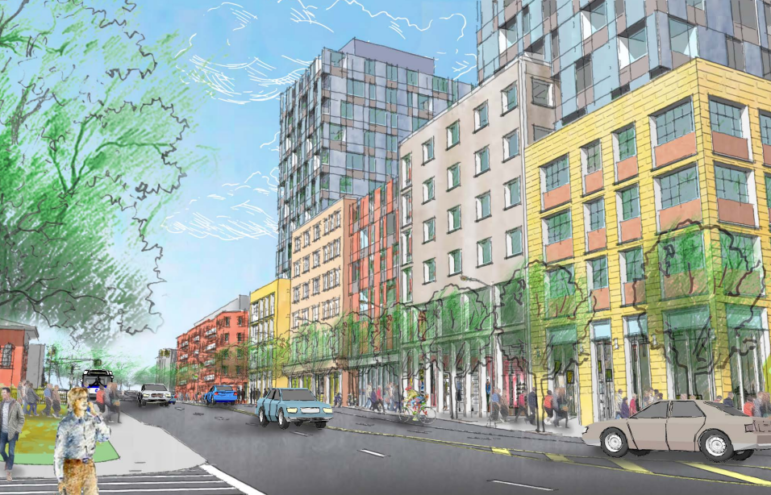
NYC DCP
A rendering in a de Blasio administration presentation on the rezoning envisions what the new Bay Street corridor will look like.
On Tuesday, the City Council’s Land Use Committee unanimously approved the Bay Street Corridor rezoning, putting the Staten Island community on a clear path toward becoming the sixth neighborhood reshaped as part of the de Blasio administration’s housing plan.
The 19-member committee passed the rezoning plan by a 15-0 vote, with three members absent (Ritchie Torres, Costa Constantinides and Andy King) and one member on paternity leave (Stephen Levin). The final vote will be held by the City Council and then Mayor de Blasio can sign or veto the plan.
The subcommittee on Zoning and Franchises voted to approve the plan last week after local Councilmember Debi Rose announced what she said was a successful completion to negotiations with the city.
The Bay Street Corridor rezoning will be accompanied by an estimated $250 million worth of investments, including funding for rebuilding the Cromwell Recreation Center, sewer upgrades, street improvements along Bay Street and around the Tompkinsville and Stapleton SIR stations, and improvements to Village Hall at Tappen Park, according to Rose’s office.
The rezoning proposal aims to rezone 20 blocks along the Bay Street and Canal Street corridors, which have not seen any zoning changes since 1961. The Bay Street Corridor is currently a light manufacturing district and the area west of Bay Street is a lower-density residential district for one and two-family detached homes. The city wants to amend the zoning there to R6B, which applies to traditional row-house districts; new housing there will fall under the Mandatory Inclusionary Housing (MIH) program requiring the creation of income-targeted units.
Along the Canal Street Corridor, blocks surrounding Beach Street and Canal Street are currently zoned as R3-2 and R4 districts, allowing for low-rise, multifamily apartment houses and detached and semi-detached one- and two-family residences. The city proposes to change the zoning to R6 for medium-density residential use*.
The proposal also includes the development of two city-owned properties, 55 Stuyvesant Place and 539 Jersey Street, for job creation and mixed-use (commercial and residential) development with affordable housing. The two nearby special districts, the Special Stapleton Waterfront District and Special St. George District, will be expanded and remain for commercial, residential and retail use.
Options 1 and 3 of the city’s Mandatory Inclusionary Housing Program would apply to the rezoning area. Option 1 requires that 25 percent of units are affordable to families making an average of 60 percent Area Median Income (AMI), or $56,340 for a family of three. Option 3, known as the Deep Affordability Option, requires that 20 percent of the rent-restricted units be affordable to families making 40 percent AMI (or $37,560 for a family of three).
Rose also secured 100 percent affordable housing at 539 Jersey Street (with a minimum of 20 percent of the affordable housing on the site reserved for households making less than 50 percent of AMI and 90 units of senior housing) and the New Stapleton Waterfront Site A, the northernmost development site, will have 100 percent affordability by the end of 2020 with a minimum of 30 percent for Extremely Low and Very Low Income Households (those earning up to 30 percent and up to 50 percent of the Area Median Income, respectively; 30 percent of AMI is $28,170 for a family of three).
But the rezoning deal has been met with mixed reaction. Members of Staten Island Community Board 1 said they felt funding for the new Cromwell Recreation Center should have been separate from the rezoning because that was an earlier promise made by the de Blasio administration. Housing and tenant advocacy groups have raised concerns about displacement.
Get the best of City Limits news in your inbox.
Select any of our free weekly newsletters and stay informed on the latest policy-focused, independent news.
One of the more vocal critics has been Staten Island Borough President James Oddo, who called on the city for a full analysis of services such as police, fire, emergency response, local hospitals and sanitation to quantify how service levels will be affected and if additional funding for those services would be needed to meet the demand of the future 6,500 residents.
According to the environmental impact statement , the rezoning will lead to an increase in housing by 2,557 dwelling units and would likely increase the population by 6,571 new residents.
But Rose, who was not present for the Committee on Land Use vote Tuesday, said in last week’s press statement, “All of these commitments include many strategies to ensure that the North Shore is better equipped to deal with the new housing and population growth accompanying this development. I fought for the City to make good on their prior commitments, fought for the best for the North Shore, and fought to respond to the stakeholders who voiced their concerns. With local stakeholder support, I believe we have reached a plan that will meet the needs of our neighborhoods, but more importantly will be a roadmap to a new investment in Staten Island, and create vital opportunities for the future of our borough.”
*Correction: The initial version of this story erroneously reported that R6B zoning includes buildings up to 13 stories; in fact, R6B zoning has a 55-foot height limit, but R6 zoning—which is also part of the rezoning—could reach 13 stories.








